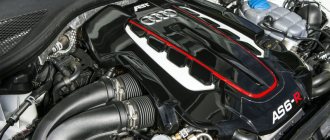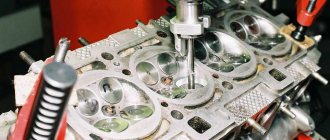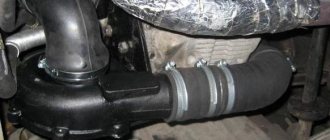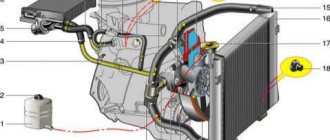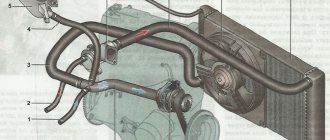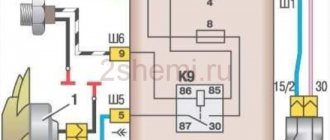1
— Expansion tank plug.
2
- Expansion tank.
3
- Radiator supply hose.
4
- Hose from the radiator to the expansion tank.
5
- Radiator outlet hose.
6
- Left radiator tank.
7
- Aluminum radiator tubes.
8
— Sensor for turning on the electric fan.
9
— Right radiator tank.
10
- Drain plug.
11
- Radiator core.
12
— Electric fan casing.
13
— Electric fan impeller.
14
- Electric motor.
15
- Pump toothed pulley.
16
- Pump impeller.
17
- Toothed camshaft drive belt.
18
— Heater radiator outlet pipe.
19
— Pump supply tube.
20
— Fluid supply hose to the carburetor starter.
21
- Carburetor heating unit.
22
- Exhaust pipe.
23
- Heater inlet pipe.
24
- Fluid drain hose from the carburetor heating unit.
25
- Thermostat.
26
— Hose from the expansion tank to the thermostat.
Why you need an engine cooling system can already be guessed from the name - when working, the engine heats up and cools through the radiator. That's it in a nutshell. In fact, the task of the engine cooling system is to maintain its temperature in a certain range (85-100 degrees), called operating temperature. At operating temperature, the motor operates as efficiently and safely as possible.
Essential elements
The engine cooling system contains the following elements:
- Cooling jacket or “water jacket”. It is a system of channels passing through the cylinder block.
- A cooling radiator is a device for cooling the liquid itself. Consists of channels of curved pipes and metal fins for better heat transfer. Cooling occurs both due to the counter flow of air and an internal fan.
- Fan. An element of the cooling system designed to enhance air flow. On modern cars, it turns on only when the temperature sensor is triggered, when the radiator is unable to fully cool the liquid with the oncoming air flow. In older car models, the fan runs constantly. Rotation is transmitted to it from the crankshaft through a belt drive.
- Pump or pump. Provides circulation of coolant through the system channels. Driven by a belt or gear drive from the crankshaft. As a rule, powerful engines with direct fuel injection are equipped with an additional pump.
- Thermostat. The most important part of the cooling system, controlling circulation through a large cooling circle. The main task is to ensure normal temperature conditions during vehicle operation. Usually installed at the junction of the inlet pipe and the cooling jacket.
- The expansion tank is a container necessary to collect excess coolant that occurs during the heating process.
- Heating radiator or stove. Its design is similar to a cooling radiator in a smaller size. However, it is used exclusively for heating the car interior in winter and does not play a direct role in cooling the internal combustion engine.
Air or dropsy
The cooling system of an internal combustion engine is designed to remove excess heat from engine parts and components. In fact, this system is bad for your pocket. Approximately a third of the heat obtained from the combustion of precious fuels has to be dissipated into the environment. But this is the structure of a modern internal combustion engine. The ideal would be an engine that can operate without dissipating heat to the environment, and convert all of it into useful work. But the materials used in modern engine construction will not withstand such temperatures. Therefore, at least two main, basic engine parts - the cylinder block and the cylinder head - have to be additionally cooled. At the dawn of the automotive industry, two cooling systems appeared and competed for a long time: liquid and air. But the air cooling system gradually lost its ground and is now used mainly on very small motor vehicle engines and low-power generator sets. Therefore, let’s take a closer look at the liquid cooling system.
Circles of circulation
The cooling system in a car has two circulation circles: large and small. The small one is considered the main one, since when the unit is started, coolant immediately begins to circulate through it. In the operation of the small circle, only the channels of the cylinder block, the pump, and the interior heating radiator are involved. Circulation takes place in a small circle until the internal combustion engine reaches normal operating temperature, after which the thermostat activates and opens the large circle. Thanks to this system, engine warm-up is significantly reduced, and in winter, the system does not so much cool the unit as maintain its normal temperature regime.
Small and large coolant circulation circles
The operation of the large circle involves a fan, a cooling radiator, inlet and outlet channels, a thermostat, an expansion barrel, as well as those elements that take part in the functioning of the small circle. The outer circle, also known as the large circle, begins to work when the coolant temperature reaches 80-90°C and ensures its cooling.
Types of engine cooling systems
The temperature of a car engine can be controlled using coolant (antifreeze, coolant) and air circulation. Based on this, three types of systems are distinguished:
- Air. Physically it is a blower, due to which hot air is displaced from the engine compartment into the atmosphere. Air cooling can be natural or forced (using a fan). Due to low efficiency, it is practically not used as an independent system.
- Liquid. It is a system of tubular circuits through which coolant circulates. Liquid cooling can be forced (pumping), thermosiphon (due to the difference in density of heated and cooled liquids) and combined (cooling of the cylinder head is forced, and the rest of the components are cooled using the thermosiphon principle). Such a system is more efficient than an air system, but under certain operating conditions (long periods of idle time with the engine running, elevated ambient temperatures) it may not be sufficient for high-quality cooling.
- Combined. It involves the use of both air flow and liquid circuits.
Liquid-based cooling systems are also divided into open and closed. The former have communication with the atmosphere using a steam outlet tube, and the latter, the liquid is completely isolated from the environment. In closed systems, the antifreeze pressure is higher, and therefore the boiling point is higher. This allows them to be used at high liquid heating temperatures (up to 120°C).
How the system works
In general, the operation of the system is quite simple. A powered hydraulic pump circulates coolant through the cylinder block jacket. The circulation speed depends on the number of revolutions of the internal combustion engine crankshaft.
Antifreeze passing through the channels in the cylinder block removes excess heat from the unit and enters back into the receiving compartment of the pump, bypassing the thermostat. When the coolant temperature reaches 80-90°C, the thermostat opens a large circulation circle, blocking the small one. Thus, the liquid after the cylinder block is directed to the cooling radiator, where its temperature is reduced due to the oncoming air flow and the fan. Next, the process is repeated.
Despite the simplicity of the design, the cooling system of the power unit can fail during vehicle operation. In this regard, the engine will operate at elevated temperatures, which will significantly reduce the service life of its parts. The reasons for incorrect cooling operation can be completely different.
Coolant circulation diagram
Simple refrigerant circulation diagram
Now let's talk about the path through which fluid circulates in the internal combustion engine of a car. The information below is relevant for all engines, regardless of how many cylinders they have.
So, the liquid circulates as follows:
- You start the engine, the consumable material immediately begins to flow through the CO lines. At this stage, circulation is carried out using a pumping device. It comes into operation as a result of the influence of the timing belt or a special belt.
- The coolant has not yet heated up, so it is pumped into the power unit using a pumping device. The consumable material begins to heat up as a result of its circulation through the cylinders of the internal combustion engine, which give off heat. Antifreeze begins to absorb heat, thus increasing its temperature. After this, the refrigerant flows to the pump. This is a small circle and it is repeated until the refrigerant warms up completely.
- A large circulation circle of the consumable material comes into operation after the liquid has warmed up to the desired temperature. When it starts working, the thermostat blocks the small circle. Using a pumping device, the consumable material begins to be pumped into the engine. The liquid, having an elevated temperature, circulates through the lines and enters the radiator. Here it leaves some of the heat, transferring it to the heating system or to the environment.
- After this, the refrigerant is again pumped into the car engine by a pumping device. If the consumable cannot provide proper cooling of the motor, while the temperature of the liquid continues to rise, the fan sensor comes into operation. It is usually mounted at the bottom of the radiator unit. Its activation causes the fan to start operating.
- After the antifreeze has cooled to the desired temperature, the fans turn off.
The Fusion Plus channel published a video demonstrating the operation of the cooling system.
Thermostat wear
Most often, problems in the system are associated with the valve that switches the circulation circles, also known as the thermostat. If a part jams in one position or the valve does not close the channels of the circulation circles tightly, warming up the engine may take much longer or, conversely, the unit will begin to overheat severely without sufficient cooling.
Thermostat operating principle
As a rule, thermostat failure is associated with a violation of its integrity. The basis of the valve is thermal wax, which, when heated, expands and compresses the membrane, opening a large circulation circle. If the wax leaks out of the part for any reason, the valve will stop functioning and the antifreeze will not be able to fully cool. Wear may also be caused by untimely replacement of the coolant or its poor quality. Corrosion of the thermostat spring causes the part to jam in the open or, less commonly, closed position. In both cases, the engine will not be able to operate in the normal temperature range - the liquid will either be constantly cooled, even when it is not necessary, or, conversely, will be hot all the time.
Thermostat spring is corroded
Determining wear is quite simple and can be done in two ways. The easiest way to check is with a non-removable method. To do this, immediately after starting the engine, touch the radiator inlet pipe. If it becomes warm almost immediately after starting the engine, this indicates that the thermostat is stuck in the open position. Conversely, when the hose remains cold even if the temperature indicator is at its peak, this indicates an inability of the thermostat to open.
You can more accurately verify that the reason for the incorrect operation of the cooling system lies precisely in the malfunction of the thermostat by dismantling it. The removed valve is placed in a container of water and heated. When the water temperature reaches 90°C, a working valve must work - the thermostat rod will move. If this does not happen, you can confidently consider the part to be faulty.
A failed thermostat cannot be repaired and must be replaced. Its cost for most cars rarely exceeds 1000 rubles. It is quite possible to replace the valve yourself, without visiting a car service center.
Fluid replacement and flushing
If you have not had to replace any component in the cooling system before, then the instructions recommend changing antifreeze at least every 5–10 years. If you have never had to add water to the system from a canister, or even worse, from a roadside ditch, then when replacing the fluid, the system does not need to be flushed.
But if the car has seen a lot in its lifetime, then when replacing the fluid it is useful to flush the cooling system. Having opened the system in several places, you can thoroughly rinse it with a stream of water from a hose. Or simply drain the old liquid and fill with clean, boiled water. Start the engine and warm up to operating temperature. After waiting until the system cools down, so as not to get burned, drain the water. Then purge the system with air and add fresh antifreeze.
Flushing the cooling system is usually started in two cases: when the engine overheats (this manifests itself primarily in the summer) and when the stove stops heating in winter. In the first case, the reason lies in the radiator tubes overgrown with dirt on the outside and clogged on the inside. In the second case, the problem is that the heater radiator tubes are clogged with deposits. Therefore, during a scheduled fluid change and when replacing cooling system components, do not miss the opportunity to thoroughly rinse all components.
Tell us what cooling system malfunctions you have encountered. And I wish you a hot heater in winter and good cooling in summer.
radiator 3, fan 1, liquid pump 8, cylinder block cooling jacket, cylinder head cooling jacket, thermostat 10, pipes 6, 17, hoses 9, expansion tank, fluid temperature monitoring devices 13, drain valves 18, 19.
Hydraulic pump problems
One of the reasons for overheating of the car’s power unit may be a malfunction of the cooling system pump. Most often the problem is that the hydraulic pump drive belt has broken or its tension is too weak. In this case, the pump will stop pumping antifreeze, or will not do it fully. Checking this is quite simple, you just need to bring in the engine and observe the behavior of the drive belt. If it works with slippage, the tension should be increased or the belt should be completely replaced with a new one. Most often this solves the problem.
Situations arise when the problem lies in the pump itself: wear of the impeller, bearing, and sometimes even a crack in the shaft. Among other things, the joints connecting the pipes to the pump may not be sealed, and the pressure created by the pump will cause a coolant leak. Diagnosing a leak is quite simple; you need to place sheets of white paper on the floor under the engine for several hours. If even small spots of blue or greenish color are visible on it, this indicates wear on the pump gaskets.
You can check the functionality of the pump itself by holding the upper radiator hose with your fingers for a few seconds while the unit is running. A working pump will create strong pressure and after releasing the hose, you will feel as if the liquid is quickly running along the line. It is also worth remembering that increased noise of the internal combustion engine and play in the pump pulley indicate bearing wear. Usually its wear is associated with fluid seeping through the seal, which washes the lubricant from the bearing.
Water pump design for engine cooling system
The coolant pump, unlike the thermostat, can be partially replaced, but often car owners prefer to completely change the mechanism.
It is recommended to replace the pump every 90,000 km, or after every second replacement of the timing belt (gas distribution mechanism).
Pump replacement:
- First of all, it is necessary to disconnect the vehicle's mass from the battery, and the piston of the first cylinder must be at top dead center. Dismantle the belt tension roller and remove the camshaft pulley.
- Next, you should drain the coolant from the bottom plug in the radiator.
- After unscrewing the pump's mounting bolts, it must be disconnected from the cylinder block.
- By visually assessing the removed mechanism, it is important to determine its wear. If the impeller, oil seal and drive gear are damaged, it is better to replace the pump completely.
- The new mechanism must be installed with a new gasket, since the old one may have even minor damage, which will subsequently lead to a coolant leak. The pump is installed so that the number indicated on the body faces up.
- Further assembly is carried out in the reverse order of disassembly. It is better to fill in new coolant, but you can also use the existing one if its resource has not yet been exhausted.
How to systematize knowledge and gain practical skills on the topic?
The licensed educational product “Automotive Fundamentals” on the LCMS ELECTUDE platform will help you study the topic “Lubricating and Cooling Systems” in detail.
A video review of this training product is available for you right now:
A huge advantage of using the platform is that you not only consistently receive the necessary set of knowledge, but have the opportunity to work with devices in practice, hone your diagnostic and repair skills (the platform has a built-in simulator).
The platform is adaptive for both classroom and distance learning. It is very convenient that the system has a well-thought-out test system. You can not just study the material, but monitor how it has been learned and what real progress has been made in studying the engine cooling system.
Radiator and fan problems
Insufficient engine cooling may be due to problems with the radiator and fan. First of all, it is worth remembering that a radiator that is too clogged with dust and insects is unable to be fully cooled either by the oncoming air flow or by the fan. Often cleaning it solves the cooling problem.
The design of a “classic” engine cooling radiator. In many modern engines, coolant is not poured through the radiator neck, but into the expansion tank.
And yet, more serious situations are also possible - radiator cracks, which can occur both during an accident and as a result of corrosion. In most cases, the radiator can be restored. Brass and copper are repaired using soldering, and aluminum with special sealants.
Before soldering, the damaged areas are thoroughly cleaned with emery cloth until a metallic shine appears. Afterwards, the crack is treated with soldering flux and a uniform layer of solder is applied using a powerful soldering iron (see video).
It is not possible to solder an aluminum radiator, however, special sealants are offered for repairing them, or you can use regular “cold welding”. Before starting to seal cracks, it is important to thoroughly clean the defective areas. The adhesive mass is well kneaded until smooth and applied to the problem area. It is worth remembering that the car can only be used the next day after repair - epoxy glue takes quite a long time to dry.
We recommend reading the article “Do-it-yourself car radiator repair”
As for the cooling fan, its failure may be due to a break in the electrical wiring or a disruption of the drive from the crankshaft if the rotation is transmitted from the power unit.
In the first case, it is worth visually assessing the condition of the wires going to the fan motor; if a break is detected, you need to reconnect the damaged contacts. If the condition of the wires is normal, but the fan still does not work, the motor itself or the sensor responsible for its timely activation may have broken down. In this case, it is better to contact a car service center, where they will determine the reason why the fan does not turn on. If there are problems with the sensor, the airflow may either continuously or not turn on at all.
In cars where the fan begins to rotate when transmitting torque from the engine, the breakdown is most often associated with a broken drive belt. Replacing it is quite simple: you need to loosen the pulley tension and install a new belt.
Read more about the design and repair of a cooling fan here.
The hydraulic cooling system requires timely flushing of the lines, otherwise corrosion, salt deposits, and other contaminants may form on the walls of the channels.
CO components
The operation circuits of cooling mechanisms include many elements. Each of the parts performs its own functions; accordingly, for the ideal operation of all systems, the elements must be in good condition, and they must not be affected by external negative factors. There are times when coolant is not circulating and this is a sign that one of the components is not working properly.
- Radiator. Its task is to reduce the temperature of the refrigerant under a constant flow of cold air. Heat output is increased, thereby increasing efficiency and cooling capabilities, allowing you to get more work done in less time.
- An oil radiator can be installed along with the main one. It is designed to cool the lubricant.
- Another type of device of the same type is a radiator designed to cool exhaust gases. It is necessary to reduce the combustion temperature of the fuel mixture.
- The job of the heat exchanger is to heat the air. The operation of this device will be more efficient if it is installed at the point where the coolant exits the engine.
- The expansion tank helps compensate for the changing volume of coolant as a result of its expansion.
- The circulation and movement of coolant is provided by a centrifugal thrust pump. Such a pump is often called a pump. The operating system may vary depending on the type of device. In particular, there are pumps on a belt, and there are pumps on gears. Some powerful engines require the installation of an additional pump of the same type.
- Thermostat. The purpose of this device is to set the level and amount of refrigerant. All refrigerant is controlled, thereby maintaining the most acceptable temperature conditions. You can find the thermostat in the middle between the radiator and the cooling jacket in the pipe.
- An electrically heated thermostat is also found on powerful engines. Full opening of such a thermostat occurs under heavy load on the internal combustion engine.
- The fan is an important part of the radiator. It increases the cooling intensity and can operate on different drives such as mechanical, electric or hydraulic. Most often, cars are equipped with an electric drive.
- The control system elements have their own purpose and allow you to use the entire system to its full potential. The temperature sensor displays the necessary information on the screen, converting it into a signal.
- The electronic control unit receives signals from the sensor, converts them into execution signals and transmits a coded signal to the same devices.
- Executing devices perform the tasks assigned to them after receiving a certain signal. Among them are: heater, relay, fan control unit, another relay for the engine.
Causes of clogging
The main reason for system contamination is the use of ordinary water as a coolant. Running water from the tap contains a large amount of salts, which creates scale and rust on the walls of the lines. The use of distilled water is less harmful, but it is not able to provide complete cooling during the hot period. In addition, in winter, at sub-zero temperatures, water will freeze and, expanding, can damage the integrity of individual parts and connections.
The use of high-quality antifreeze or antifreeze is more advisable. Special cooling substances have a significant resource and do not freeze even at very low temperatures. However, the additives contained in the composition begin to precipitate over time, clogging the system.
Expansion tank cap
Another irreplaceable component of the system is the plug. There are two types of construction - sealed and non-sealed. If the latter is used on the car, the expansion tank plug has only a drainage hole through which the pressure in the system is balanced.
But if a sealed system is used, then there are two valves in the plug - an inlet (takes air inside from the atmosphere, operates at a pressure below 0.2 bar) and an outlet (operates at a pressure above 1.2 bar). It removes excess air from the system.
It turns out that the pressure in the system is always greater than in the atmosphere. This allows you to slightly increase the boiling point of the antifreeze, which has a beneficial effect on engine performance. This is especially good for driving through traffic jams in urban environments. An example of a sealed system is VAZ-2108 and similar cars. Unsealed - models of the classic VAZ series.
Washing process
First of all, before flushing, all coolant is drained through the drain plug on the radiator, located at the very bottom, and on the cylinder block to remove any residue.
It is important to remember that draining the fluid should only be done on a cold engine!
After draining, the plugs are tightened again and water with citric acid or, better yet, a special cleaning liquid is poured into the expansion tank.
The process of pouring PRESTONE Super Radiator Flush into the expansion tank
Next, the engine starts and idles for 15 minutes. In this case, care should be taken to open a large circulation circle. Also, when washing, do not forget that the cabin stove should operate in maximum heating mode. When the unit has cooled down, the liquid can be drained by opening the radiator and cylinder block plugs. It is recommended to repeat this process until clean liquid without visible contaminants flows out when draining.
Filling with new coolant can be done immediately after flushing is completed. Pour antifreeze or antifreeze into the expansion barrel carefully and slowly to avoid the formation of air locks in the system.
When pouring antifreeze or antifreeze, use a funnel - this will prevent coolant from getting on engine parts.
When the tank is almost completely filled, you need to close it and start the internal combustion engine for a few minutes so that the liquid spreads evenly throughout the system. Next, after turning off the unit, antifreeze or antifreeze is added to the level between the maximum and minimum marks on the barrel.
In conclusion, it is worth saying that there is no fundamental difference in the use of antifreeze or antifreeze. However, in many countries around the world, car manufacturers have long stopped using antifreeze, since its effectiveness is somewhat lower. Modern antifreeze is manufactured using the latest technologies and better protects the engine from overheating and the cooling system lines from contamination.
The influence of temperature parameters on motor operation
During one operating cycle, the temperature in the internal combustion engine cylinders changes from 80...120 degrees Celsius during the intake of the combustible mixture to 2000...2200 degrees Celsius during its combustion. In this case, the power unit gets quite hot.
It is generally accepted that the engine is functioning normally if the temperature range in the area of the cylinder block is within 90 - 110 degrees Celsius.
If the motor is not cooled intensively enough during operation, its parts become very hot and change in size. The volume of engine oil poured into the crankcase also decreases significantly (due to burnout). As a result, friction between interacting parts increases, which leads to their rapid wear or even jamming.
However, overcooling of the internal combustion engine also negatively affects its operation. Condensation of fuel vapor occurs on the cylinder walls of a cold engine, which, washing away the lubricant layer, dilutes the engine oil in the crankcase.
To eliminate the negative consequences associated with violation of the thermal regime, cooling systems are designed to prevent overheating and overcooling of the motor during operation.
As a result, the chemical properties of the latter deteriorate, which contributes to:
- increased engine oil consumption;
- intensive wear of rubbing surfaces;
- drop in power of the power unit;
- increased fuel consumption.
